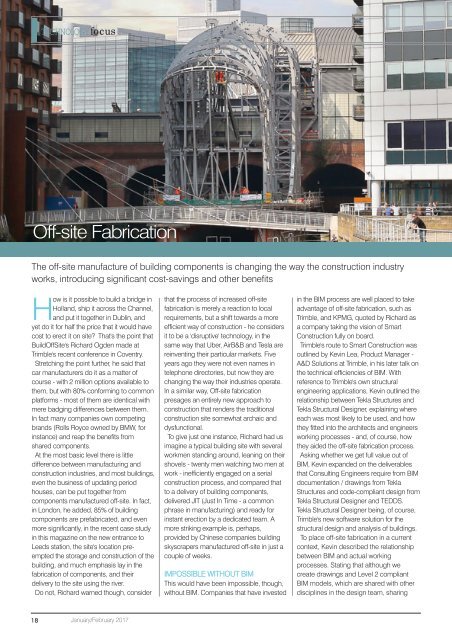CC3001
Create successful ePaper yourself
Turn your PDF publications into a flip-book with our unique Google optimized e-Paper software.
TECHNOLOGYfocus<br />
Off-site Fabrication<br />
The off-site manufacture of building components is changing the way the construction industry<br />
works, introducing significant cost-savings and other benefits<br />
How is it possible to build a bridge in<br />
Holland, ship it across the Channel,<br />
and put it together in Dublin, and<br />
yet do it for half the price that it would have<br />
cost to erect it on site? That's the point that<br />
BuildOffSite's Richard Ogden made at<br />
Trimble's recent conference in Coventry.<br />
Stretching the point further, he said that<br />
car manufacturers do it as a matter of<br />
course - with 2 million options available to<br />
them, but with 80% conforming to common<br />
platforms - most of them are identical with<br />
mere badging differences between them.<br />
In fact many companies own competing<br />
brands (Rolls Royce owned by BMW, for<br />
instance) and reap the benefits from<br />
shared components.<br />
At the most basic level there is little<br />
difference between manufacturing and<br />
construction industries, and most buildings,<br />
even the business of updating period<br />
houses, can be put together from<br />
components manufactured off-site. In fact,<br />
in London, he added, 85% of building<br />
components are prefabricated, and even<br />
more significantly, in the recent case study<br />
in this magazine on the new entrance to<br />
Leeds station, the site's location preempted<br />
the storage and construction of the<br />
building, and much emphasis lay in the<br />
fabrication of components, and their<br />
delivery to the site using the river.<br />
Do not, Richard warned though, consider<br />
that the process of increased off-site<br />
fabrication is merely a reaction to local<br />
requirements, but a shift towards a more<br />
efficient way of construction - he considers<br />
it to be a 'disruptive' technology, in the<br />
same way that Uber, AirB&B and Tesla are<br />
reinventing their particular markets. Five<br />
years ago they were not even names in<br />
telephone directories, but now they are<br />
changing the way their industries operate.<br />
In a similar way, Off-site fabrication<br />
presages an entirely new approach to<br />
construction that renders the traditional<br />
construction site somewhat archaic and<br />
dysfunctional.<br />
To give just one instance, Richard had us<br />
imagine a typical building site with several<br />
workmen standing around, leaning on their<br />
shovels - twenty men watching two men at<br />
work - inefficiently engaged on a serial<br />
construction process, and compared that<br />
to a delivery of building components,<br />
delivered JIT (Just In Time - a common<br />
phrase in manufacturing) and ready for<br />
instant erection by a dedicated team. A<br />
more striking example is, perhaps,<br />
provided by Chinese companies building<br />
skyscrapers manufactured off-site in just a<br />
couple of weeks.<br />
IMPOSSIBLE WITHOUT BIM<br />
This would have been impossible, though,<br />
without BIM. Companies that have invested<br />
in the BIM process are well placed to take<br />
advantage of off-site fabrication, such as<br />
Trimble, and KPMG, quoted by Richard as<br />
a company taking the vision of Smart<br />
Construction fully on board.<br />
Trimble's route to Smart Construction was<br />
outlined by Kevin Lea, Product Manager -<br />
A&D Solutions at Trimble, in his later talk on<br />
the technical efficiencies of BIM. With<br />
reference to Trimble's own structural<br />
engineering applications, Kevin outlined the<br />
relationship between Tekla Structures and<br />
Tekla Structural Designer, explaining where<br />
each was most likely to be used, and how<br />
they fitted into the architects and engineers<br />
working processes - and, of course, how<br />
they aided the off-site fabrication process.<br />
Asking whether we get full value out of<br />
BIM, Kevin expanded on the deliverables<br />
that Consulting Engineers require from BIM<br />
documentation / drawings from Tekla<br />
Structures and code-compliant design from<br />
Tekla Structural Designer and TEDDS.<br />
Tekla Structural Designer being, of course,<br />
Trimble's new software solution for the<br />
structural design and analysis of buildings.<br />
To place off-site fabrication in a current<br />
context, Kevin described the relationship<br />
between BIM and actual working<br />
processes. Stating that although we<br />
create drawings and Level 2 compliant<br />
BIM models, which are shared with other<br />
disciplines in the design team, sharing<br />
18<br />
January/February 2017

















